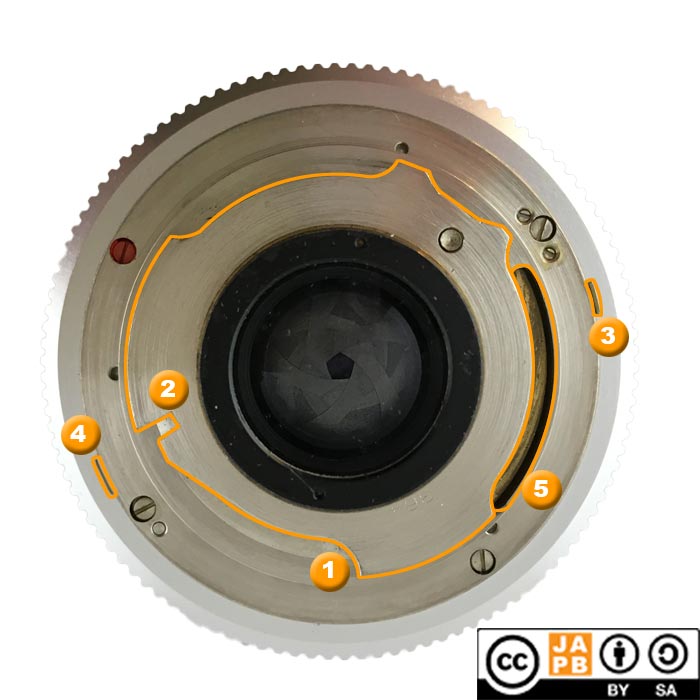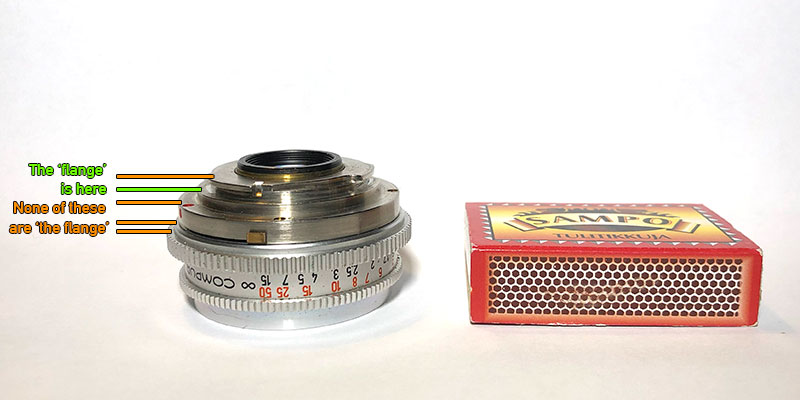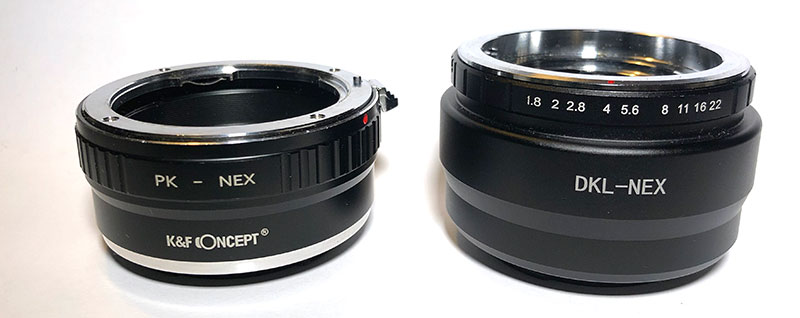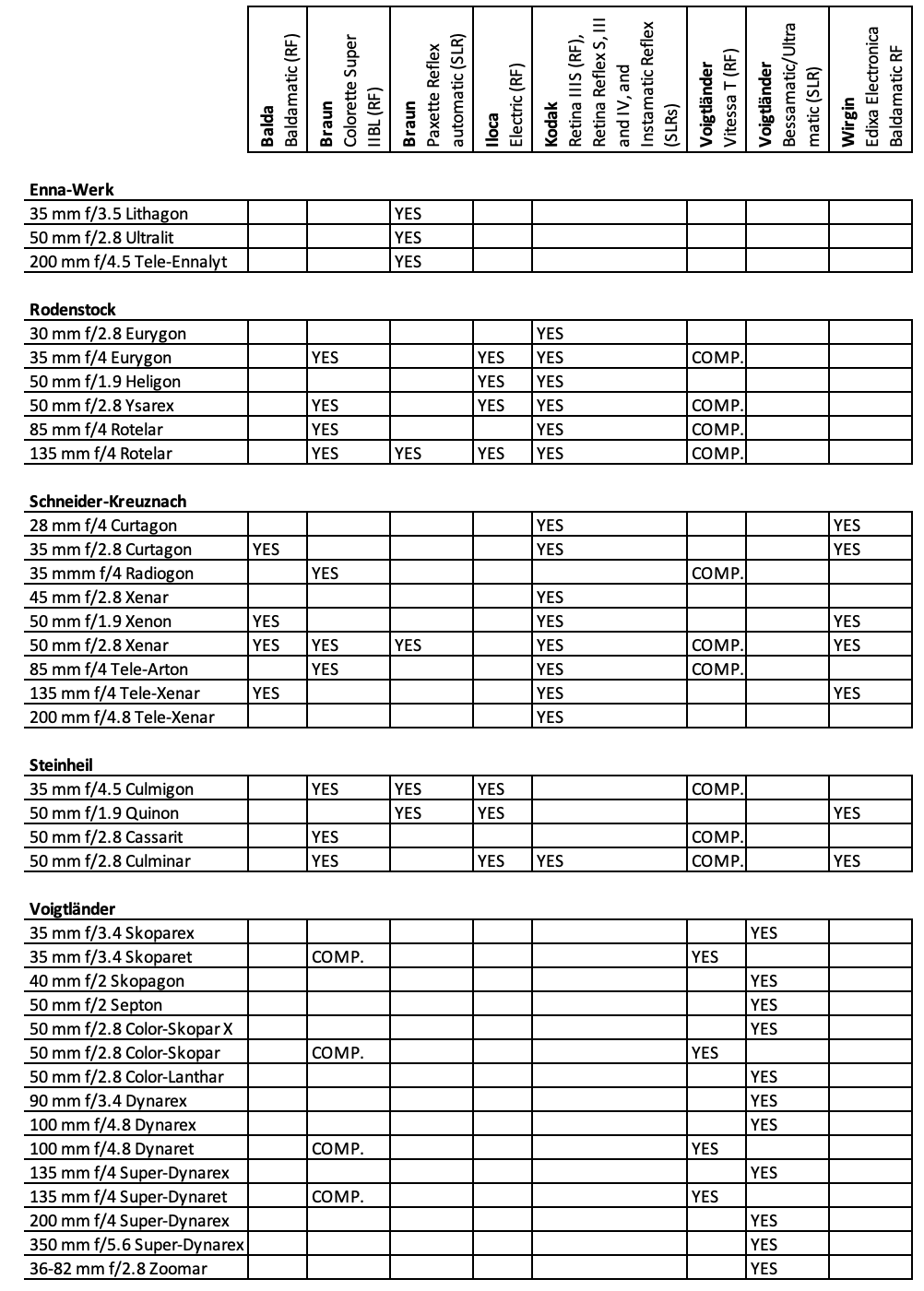Pekka Buttler (Updated May 2025)
WTF DKL?
Never heard of DKL? Well, you’re not alone.
DKL is the classification for a family of lens mounts used in a several families of leaf shutter cameras (both SLR and rangefinder). For simplicity’s sake that family of lens mounts will be referred to simply as the DKL mount.
DKL mount specifications and identification
Mount type: Bayonet (lens release on body)
Flange focal distance: 44,7 mm
Film format: 36mm x 24mm (‘Full frame’)
Mount communication: One lever for selected aperture (camera-to-lens); another for aperture stop-down (camera to lens).

Key characteristics:
[1] Eccentrically shaped bayonet (note please, some DKL lenses do not share this exact shape… read on.)
[2] Locking notch at about 02:30
[3] Aperture stop-down lever (this operates the aperture stop-down and moves independently of [4])
[4] Aperture designator lever (this sets the aperture to stop down to. When this lever is moved, also lever [3] moves).
History
Back in the 1950’s it was yet unclear which shutter technology – leaf shutters or focal plane shutters – would ultimately rule the field of professional and prosumer cameras. While both the German and Japanese photographic industry had introduced a number of new marvels based on focal plane shutters, none of the central companies manufacturing leaf shutters were yet ready to give up without a fight.
As a result, both Gauthier (manufacturers of Prontor leaf shutters) and Deckel (manufacturers of Compur leaf shutters) designed their own interchangeable lens mounts that integrated a leaf shutter in the camera-end of the lens mount. Gauthier’s solution is today known as the SLK bayonet, and Deckel’s as the DKL bayonet (you sometimes also find it referred to as the Deckel bayonet or bayonet-compur) 1.
Deckel approached the field of German camera manufacturers and was able to attract a number of them to adopt the DKL bayonet, including:
• Balda
• Braun (Colorette Super II)
• ILOCA,
• Kodak (Germany)
• Voigtländer, and
• Wirgin
But although leaf shutters were a mature technology, the ‘leaf shutter integrated in mount’ took some time to settle into a workable solution (initial DKL lenses had aperture rings, later these moved to the camera-end of the mount). Also, while the first generation of DKL cameras were rangefinders, Deckel saw that reflex cameras were on the rise and developed another implementation ‘suitable’ for SLR’s 2.
Some of those companies that adopted the DKL mount used them only for rangefinders (Balda, ILOCA), others started with rangefinders then also implemented SLRs (Braun, Kodak, Voigtländer) and some used the DKL mount only for SLRs (Wirgin)
Problematically, what had been at one point thought of as a potential “(west) German unified mount” started fragmenting, and various users of the DKL mount started implementing their own proprietary, artificial limitations to limit the interchangeability of interchangeable lenses (pun intended) 3. Therefore, at various times, the Schneider-Kreuznach Xenar 50 mm f/2.8 was available in five non-compatible DKL versions (see lens table below).
To make matters even worse, some manufacturers even used several mutually non-interoperable versions of the DKL mount (You could not mount a Voigtländer Color-Skopar 50/2.8 made for the Voigtländer Vitessa on a Voigtländer Bessamatic, instead you had to use a Voigtländer Color-Skopar X 50/2.8 made for the Bessamatic ). A 10-letter word comes to mind, and it starts with ‘cluster’.
And while one could argue that leaf shutters in interchangeable lens reflex cameras were a technological dead-end, during the relatively short lifespan (ca 1957–1963), the line of DKL cameras did produce a few industry first’s such:
• The 1959 Voigtländer Zoomar 36-82 f/2.8 (World’s first production zoom for a 35 mm camera)
• The 1962 Edixa Electronica (first interchangeable lens SLR with full exposure automation)
Which version of the mount does my lens have?
Assuming you have identified that your lens has some variant of the DKL mount, but you’re not sure which, you can always consult the lens list below, but with some lenses that will not give you a conclusive answer. Horst Neuhaus’ site offers schemata of the mounts of all the different variants, but with many DKL lenses there’s an easy way to be certain: Very often the name ring identifies the variant.
Likely aware of the confusion that would ensue from a swathe of non-compatible yet outwardly very similar mounts, many lens manufacturers started printing the name of the intended system on the lens name ring (look out for the phrases Balda, Braun, Iloca, Retina 4 (Kodak), and Edixa (Wirgin)). Problematically this does not help in the case of Voigtländer which did not identify whether the lens was intended for SLRs (Bessamatic/Ultramatic) or Rangefinders (Vitessa). Here however the name of the lens is a conclusive identifier.
Keep in mind however that if your intention is to adapt your DKL lens, its exact variant will likely not be of any significance as most adapters manage to bridge all the intentional incompatibilities.
Today
Indeed, who cares about ancient history, and who could possibly want to use almost 70 year old optics. Well, it turns out that many do. Moreover, as most of the proprietary incompatibilities are relatively easily circumvented simply by purchasing a DKL-to-whatever adapter (oldskool lens hackers used to do this with diamond files), adapting DKL lenses is by no means as difficult as it may seem.
Finally, there is one very big attractor than can be expressed succinctly by saying: Schneider-Kreuznach, Rodenstock, Voigtländer, Steinheil, Enna.
Because whatever technological failings may have contributed to quickening the infighting-laden demise of the DKL systems, the optics used by DKL cameras were as good as they could be in the 1950’s.
Adapting DKL lenses
Irrespective of whether you want to adapt a DKL lens to an SLR or mirrorless, there are two things to consider: Firstly, the adapter must have been designed so that it allows for controlling the lens’ aperture mechanism. Secondly as the widest lens ever made for the DKL system was a Schneider Curtagon (28mm f/4), you should either be using a full-frame camera (to not incur a crop factor) or be on a mirrorless platform that allows you to use a focal reducer. Thirdly, as the various camera manufacturers did their damnedest to make the various DKL mount incompatible, you may encounter DKL adapters that are not able to adapt all DKL lenses. If you want to make sure, contact the seller in advance and ask about your lens.
Onto SLRs
Technically the flange focal distance of the DKL mount is 44,7 mm and if you’re thinking of adapting DKL lenses to dSLRs, that does not sound promising. But as the DKL lens mount is somewhat unusual, that flange focal distance is not computed from what you would ordinarily think of as the flange (the outermost part of where the lens touches the mount) but from the back-plate of the DKL mount. See pic below:

Right: Box of matches
When you further consider the rather diminutive base of DKL lenses, you’ll notice that they have no trouble fitting into (into, not onto) the mount of most post 1958 proprietary SLR mounts. It is therefore not surprising, that you can find adapters from DKL to all the most popular current SLR mounts 5.
Onto mILCs
As usual, and assuming your adapter allows you to control your DKL lens’ aperture, there are very few technical problems to be expected. Furthermore, if sub-full-frame is how you roll, you even have the option of daisy-chaining adapters to include a focal reducer (e.g. DKL-> Canon EF adapter with aperture control + Canon EF-> micro Four Thirds focal reducer )
There is one minor detail though: While one would not expect that adapting a lens that has a flange focal distance of 44,7 mm (effectively between Canon EF and Pentax K) to lead to a big adapter, that is a misconception based on the rather unorthodox structure of the DKL mount. In reality, the DKL adapter is huge (see pic below) and can effectively dwarf the smaller DKL lenses.

Right: DKL to NEX adapter
Identifying the DKL mount?
See more here.
Lens list
Below is a list of lenses made for the different versions of the DKL mount. The list may be incomplete (it’s mostly based on other sources and sleuthwork on ebay) and merely that I have not found a lens (or encountered a lens’ version for a DKL variant) does not mean that it could not exist 6. Also, keep in mind that many enterprising lens hackers may have modified their DKL-lenses to fit other DKL mounts.

Note: The Voigtländer Vitessa T and Braun Colorette lenses are Compatible (COMP). Even so, each manufacturer designed their lens specifically for one camera.
You can find data sheets for several DKL lenses on JAPB, including:
• Schneider-Kreuznach 28 mm f/4 Curtagon
• Schneider-Kreuznach 50 mm f/1.9 Xenon
• Schneider-Kreuznach 50 mm f/2.8 Xenar
• Schneider-Kreuznach 135 mm f/4 Tele-Xenar
• Voigtländer 35 mm f/3.4 Skoparex
• Voigtländer 50 mm f/2 Septon
• Voigtländer 135 mm f/4 Super-Dynarex
A Soviet DKL?
Indeed, in 1964 the Soviet Union saw the unveiling of the Zenit-4, Zenit-5 and Zenit 6 interchangeable lens SLRs, which differed from other Zenit-marque SLRs in that they used a leaf shutter and a lens mount that looks strikingly similar to a DKL mount. But compared to the minor incompatibilities that the German manufacturers inserted to inhibit interchangeability the Soviets went one step further by using a longer flange focal distance (reportedly 47,58 mm) making cross-compatibility practically impossible. The Zenit 4/5/6 were relatively unsuccessful (unreliable, badly timed) but sported an (on paper) impressive range of lenses, including the Rubin-1 – the Soviet Union’s first zoom and a lens that seems to have taken some inspiration from the Voigtländer Zoomar.
Footnotes
- Read more here and here (in german)
- Leaf shutters in SLRs are a bit of a kludge because the mirror needs to double as focal plane shutter (in the sense that the mirror may not let any light through) and the picture-taking process becomes hideously complex:
• Photographer frames, focuses etc. (Mirror is down, leaf shutter is open)
• Photographer pulls trigger (Leaf shutter is closed, aperture is stopped down, mirror is raised)
• The picture is taken (Leaf shutter opens, Leaf shutter closes)
• Return to normal (Mirror is lowered, aperture is opened, leaf shutter opens)
As one commentator puts it “[Camera] mechanics smilingly turn down repair requests [on such cameras], or turn, run and scream” (my translation) - Some details are available here.
- As a minor complication: before the introduction of the Kodak Retina IIIS (1958) and Kodak Retina Reflex S (1959), Kodak had manufactured the Retina IIc/IIIc rangefinders and the Retina Reflex SLR using the concept of set lenses (where a front-end part of the entire lens is interchangeable). The interchangeable front-ends of these lenses (by Schneider-Kreuznach and Rodenstock) also feature the phrase Retina, but with the important addition “C” (e.g. “Rodenstock 35 mm f/4 Retina Heligon C” or “Schneider-Kreuznach 35 mm f4 Retina-Curtar-Xenon C“). These are in no way compatible with DKL mount cameras or adapters.
- At the time of writing, DKL adapters were available to at least Canon EF, M42, Nikon F, Pentax K Sony/Minolta A (as well as Leica M).
- Staeble manufactured lenses for Braun Paxette cameras that used the SLK mount, and there is a source that mentions Staeble as manufacturer for lenses for the Braun Paxette Reflex as well. However as I have never managed to encounter a sample in the wild, I’ll classify this as dubious for now.